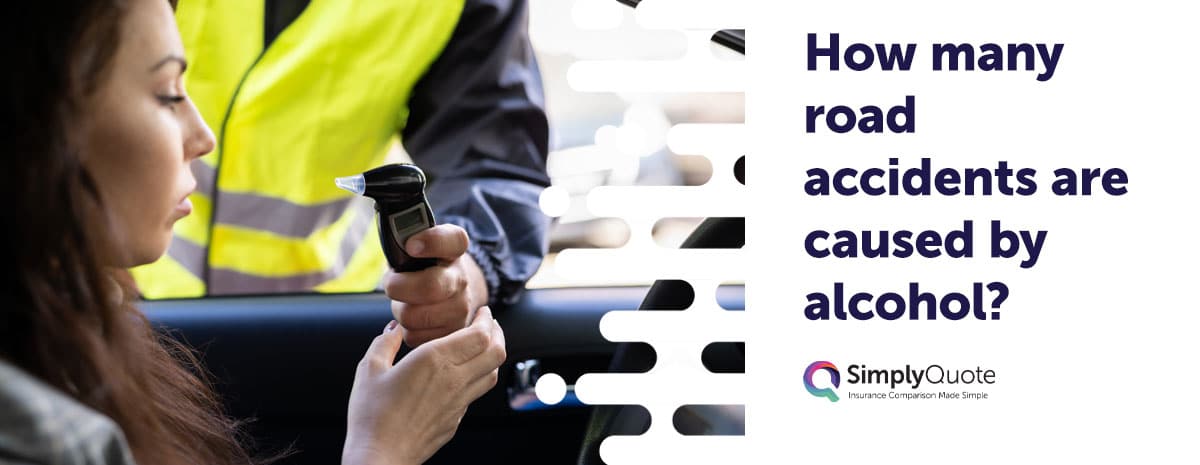How many road accidents are caused by alcohol?
In 2022, an estimated 300 people were killed in drink-driving crashes in the UK—accounting for around 18% of all road deaths.
That figure is the highest since 2009, marking a concerning shift after years of steady decline.
For decades, drink-driving has been one of the most visible road safety issues in the UK. Public awareness campaigns, changing social norms, and harsher penalties have all helped reduce the number of incidents. And yet, the problem hasn’t gone away. In fact, the latest figures suggest it’s getting worse again.
An estimated 6,800 people were killed or injured in drink-drive collisions in 2022, up slightly from the previous year. And in 2023, 14.5% of drivers tested after a crash failed a breathalyser—the highest rate since before the pandemic. These are not distant or historic problems. They are real, recent, and persistent.
This article explores the scope of alcohol-related crashes in the UK, who’s most at risk, how the law treats offenders, and what can actually be done to change the trend. Because despite everything we know about drink-driving, far too many people still get behind the wheel and take the chance.

What percentage of road accidents involve alcohol?
Alcohol is a factor in roughly 18% of all road deaths in the UK, with an estimated 300 drink-driving fatalities recorded in 2022.
That’s the highest central estimate in over a decade—and a clear sign the problem isn’t going away.
In total, around 6,800 people were killed or injured in drink-drive collisions across Great Britain in 2022. That includes passengers, pedestrians, and other road users affected by a single person’s decision to drive after drinking. Wales had the highest share of these casualties (7.3% of all road injuries), followed by England (5.2%) and Scotland (4.1%).
And the problem may be more widespread than official stats suggest. In 2023, 14.5% of motorists breathalysed after a collision tested positive—the highest rate since 2019. This means that nearly 1 in 7 post-crash tests detected alcohol above the legal limit.
What’s more, many drink-driving crashes go unrecorded. If police don’t test the driver at the scene—or if injuries are minor—the data may never capture the role alcohol played. Which means the true figure could be even higher than what’s reported.
This isn’t a niche issue. It’s a national one—and one that continues to affect thousands every year.
Looking to compare car insurance? Get your quote today!
Get QuotesWho is most at risk of alcohol-related road accidents?
Men account for up to 85% of drink-drive offences in the UK, with most offenders aged 25 and over.
That’s a sobering shift from the outdated stereotype of young, reckless drivers.
According to government figures, the majority of drink-driving convictions now involve male drivers aged 25 to 49. These are not new drivers or teens fresh out of driving school—they’re adults, often with years of experience behind the wheel. And that’s partly the problem: familiarity can breed complacency.
This age group is more likely to drive late at night, attend social events that involve alcohol, and live in areas where public transport options are limited. They may underestimate the risk, feel confident in their driving ability, or assume they’re “probably under the limit.” All of which increases the likelihood of getting behind the wheel when they shouldn’t.
Regionally, Wales sees the highest proportion of drink-drive collisions relative to overall road injuries, at 7.3%. That’s nearly double the figure in Scotland. Access to pubs and clubs without easy transport alternatives plays a role—but so does culture and habit.
Drink-driving risk doesn’t come from ignorance—it comes from overconfidence, poor judgement, and the belief that “it won’t happen to me.”
What are the legal consequences of drink-driving in the UK?
The legal consequences of drink-driving in the UK can include fines, driving bans, imprisonment, and a permanent criminal record.
Even a first offence can change your life.
The legal limit in England, Wales, and Northern Ireland is 35 micrograms of alcohol per 100ml of breath (or 80mg per 100ml of blood). In Scotland, it’s stricter: 22 micrograms per 100ml of breath, or 50mg per 100ml of blood. That means a single drink could put you over the limit, depending on your size, sex, and metabolism.
Get caught and you could face:
- A minimum 12-month driving ban
- A fine of up to £5,000
- Up to 6 months in prison
- 11 years of the offence showing on your driving record
But the fallout doesn’t stop there. Drink-driving convictions come with DR10, DR20 or DR80 endorsement codes, which stay on your licence and are visible to insurers. These codes push you into high-risk categories and can double or triple your premiums. In some cases, insurers may decline to cover you altogether.
And even once the penalty period is over, the record can affect employment—especially in jobs involving driving, childcare, or public trust.
The law is clear because the risk is clear. Driving after drinking is not just a legal gamble—it’s a personal, financial, and social one too.
Related Read: How Much Can I Drink & Still Drive?
How does alcohol affect driving ability?
Alcohol slows your reaction time, impairs judgement, reduces coordination, and increases risk-taking—all of which are deadly behind the wheel.
Even small amounts can have a measurable effect long before you feel “drunk.”
When alcohol enters the bloodstream, it affects the brain’s ability to process information and make split-second decisions. That’s why reaction times are one of the first things to decline. A driver might brake too late, miss a hazard in their peripheral vision, or misjudge the speed of an oncoming car.
It also impairs coordination—especially eye-hand and foot-eye movement. Tasks that require precise timing, like steering through tight spaces or maintaining lane discipline, become harder. Meanwhile, judgement gets clouded, making drivers more likely to take risks they wouldn’t sober: overtaking too closely, running amber lights, or underestimating braking distance.
Crucially, alcohol also causes overconfidence. Many drink-drivers believe they’re still in control—especially after “just one or two.” That misplaced self-assurance is what leads them to drive in the first place.
Studies show that even drivers under the legal limit can experience mild impairment. Add fatigue, distraction, or stress into the mix, and the risk escalates fast.
The bottom line? The effects kick in sooner than most people think. You don’t have to feel drunk to be dangerous.
Why does drink-driving remain a problem in the UK?
Drink-driving persists in the UK because awareness doesn’t always change behaviour—and enforcement alone isn’t enough.
The stats may fluctuate, but the core problem stays stubbornly in place.
In 2022, the central estimate for drink-driving fatalities reached 300 deaths, the highest number since 2009. That’s after years of campaigns, stricter penalties, and high-profile messaging. Clearly, the issue isn’t ignorance—it’s decision-making in the moment.
Many drivers still believe they’re safe after “just a couple.” Others misjudge the timing—thinking they’ve sobered up enough by the morning. And in some regions, enforcement is patchy. If breath tests aren’t routine after collisions, the sense of being caught feels distant.
Social dynamics also play a role. In rural areas or small towns where taxis are limited and public transport is rare, people may risk the drive home from the pub. In cities, it’s sometimes about convenience—picking up the car the next day sounds good in theory, until a few drinks tip into a risky choice.
And then there’s cultural fatigue. Decades of “don’t drink and drive” messaging means some people stop listening—not because they disagree, but because they think it doesn’t apply to them.
But the numbers say otherwise. Drink-driving isn’t just a past problem. It’s a present one—and its impact is measured in lives, not headlines.
What can be done to prevent drink-driving?
Preventing drink-driving starts with planning, accountability, and a refusal to gamble with “probably fine.”
Once alcohol is involved, the best decision is always to step away from the driver’s seat—no matter how minor the journey.
Practical solutions are simple but effective:
- Designated drivers still work. Agree who stays sober before the night starts—not once everyone’s already halfway through a round.
- Taxis, Ubers, or public transport aren’t just backup—they should be part of the plan. Especially in urban areas where options are accessible and affordable.
- In rural areas, arranging lifts ahead of time is critical. Assuming you’ll “see how you feel” later is what leads to bad decisions.
- If you’re hosting, offer crash space or alcohol-free alternatives. Remove the guesswork. Make the decision easy.
Technology can help too. Ignition interlocks, breathalysers, or even app reminders from car insurers using telematics could provide helpful friction points—especially for repeat offenders or high-risk drivers.
But cultural change matters just as much. Challenge mates who say they’re “fine to drive.” Support tougher enforcement. Call out normalised risk-taking when you see it.
Because no one ever plans to cause a drink-drive crash. But the moment you get behind the wheel after drinking—you’ve already made a plan with consequences.
Final thoughts
Most drink-driving crashes don’t happen because someone meant to cause harm. They happen because someone convinced themselves it would be fine.
That’s the danger. Not malice—but misjudgement.
One drink becomes two. Confidence takes over where clarity should be. The journey’s short, the roads are quiet, and the risk feels abstract—until it isn’t. Until someone steps out, brakes too late, or never makes it home.
The numbers don’t lie. Hundreds die, thousands are injured, and too many drivers still roll the dice. And every one of those collisions started with a choice.
This isn’t about fear. It’s about responsibility. For your safety, for your passengers, and for every stranger you’ll pass without even noticing.
Leave the car. Plan ahead. And don’t let “I’ll be fine” be your last thought before something avoidable becomes irreversible.
Frequently Asked Questions (FAQs)
An estimated 300 people were killed in drink-driving crashes in 2022—the highest figure since 2009.
Around 17 to 18 percent of all road fatalities in the UK are linked to at least one driver being over the legal alcohol limit.
England, Wales, and Northern Ireland have a limit of 80mg per 100ml of blood. Scotland’s limit is lower, at 50mg per 100ml.
It slows your response, clouds judgement, narrows vision, and increases the chance of missing hazards or braking too late.
You might still be over the limit. Alcohol affects people differently based on weight, gender, and metabolism. There’s no safe way to guess.
On average, it takes one hour to process each unit of alcohol. But this varies depending on your health, hydration, and what you’ve eaten.
You could face a 12-month ban, a fine of up to £5,000, six months in prison, and a conviction that stays on your licence for up to 11 years.
Yes. A first offence usually results in an immediate driving ban of at least 12 months—even if no crash occurred.
